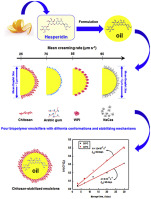当前位置:
X-MOL 学术
›
J. Food Eng.
›
论文详情
Our official English website, www.x-mol.net, welcomes your feedback! (Note: you will need to create a separate account there.)
Effect of different biopolymers on the stability of hesperidin-encapsulating O/W emulsions
Journal of Food Engineering ( IF 5.5 ) Pub Date : 2018-11-01 , DOI: 10.1016/j.jfoodeng.2018.05.004 Ilyes Dammak , Paulo José do Amaral Sobral
Journal of Food Engineering ( IF 5.5 ) Pub Date : 2018-11-01 , DOI: 10.1016/j.jfoodeng.2018.05.004 Ilyes Dammak , Paulo José do Amaral Sobral

|
Abstract In the present study, hesperidin was encapsulated in different food-grade oil-in-water (O/W) emulsions via a rotor-stator homogenizer. The innovative aspect of the assessment was the production of emulsions with high encapsulation efficiency and hesperidin stability when using chitosan as a biopolymer emulsifier. Analytical centrifugation tests revealed that the polysaccharide did not alter the Sauter mean diameter (d3,2) of the emulsions, but reduced (p υ ¯ ) (26 μm s−1) when compared to the other evaluated biopolymers. This result was due to chitosan's simultaneous mechanisms of stabilization by steric hindrance, electrostatic interactions, and increasing viscosity of the continuous phase. Chitosan at 1% (w/w), used as an emulsifier in distilled water, served as a continuous phase, while 1.0 mg mL−1 of hesperidin, in refined soybean oil, functioned as a dispersed phase. The resulting d3,2 of hesperidin-loaded O/W emulsions ranged between 4.6 and 5.0 μm, with a relative span factor below 0.3. The physical stability of the hesperidin emulsions stabilized by chitosan was characterized at different storage temperatures (20, 40, and 60 °C). The dominant physical destabilization changes over time were primarily governed by the creaming mechanism. Also, chitosan stabilization decelerated the total phase separation of hesperidin emulsions even at a high storage temperature (60 °C). The chitosan-stabilized emulsions displayed hesperidin encapsulation efficiencies of above 70% at 20 °C and 40 °C after 30 days of storage. Chitosan stabilization had an adequate impact on the reduction of the degradation rate (k) of hesperidin emulsions during 30 days of storage, thus increasing hesperidin half-life (t1/2).
中文翻译:

不同生物聚合物对橙皮苷包裹水包油乳液稳定性的影响
摘要 在本研究中,橙皮苷通过转子-定子均质器封装在不同的食品级水包油 (O/W) 乳液中。评估的创新方面是在使用壳聚糖作为生物聚合物乳化剂时生产具有高包封效率和橙皮苷稳定性的乳液。分析离心测试表明,与其他评估的生物聚合物相比,多糖没有改变乳液的 Sauter 平均直径 (d3,2),但降低了 (p υ ¯ ) (26 μm s-1)。这一结果是由于壳聚糖通过空间位阻、静电相互作用和连续相粘度增加而同时稳定的机制。1% (w/w) 的壳聚糖在蒸馏水中用作乳化剂,用作连续相,而 1.0 mg mL−1 橙皮苷,在精制豆油中,起到分散相的作用。得到的载有橙皮苷的 O/W 乳液的 d3,2 范围在 4.6 和 5.0 μm 之间,相对跨度因子低于 0.3。壳聚糖稳定的橙皮苷乳液的物理稳定性在不同的储存温度(20、40 和 60 °C)下进行表征。随着时间的推移,主要的物理不稳定变化主要受乳脂化机制的控制。此外,即使在高储存温度 (60 °C) 下,壳聚糖稳定性也能减慢橙皮苷乳液的总相分离。壳聚糖稳定的乳液在储存 30 天后在 20°C 和 40°C 下显示出高于 70% 的橙皮苷封装效率。在 30 天的储存期间,壳聚糖稳定性对降低橙皮苷乳液的降解率 (k) 有足够的影响,
更新日期:2018-11-01
中文翻译:

不同生物聚合物对橙皮苷包裹水包油乳液稳定性的影响
摘要 在本研究中,橙皮苷通过转子-定子均质器封装在不同的食品级水包油 (O/W) 乳液中。评估的创新方面是在使用壳聚糖作为生物聚合物乳化剂时生产具有高包封效率和橙皮苷稳定性的乳液。分析离心测试表明,与其他评估的生物聚合物相比,多糖没有改变乳液的 Sauter 平均直径 (d3,2),但降低了 (p υ ¯ ) (26 μm s-1)。这一结果是由于壳聚糖通过空间位阻、静电相互作用和连续相粘度增加而同时稳定的机制。1% (w/w) 的壳聚糖在蒸馏水中用作乳化剂,用作连续相,而 1.0 mg mL−1 橙皮苷,在精制豆油中,起到分散相的作用。得到的载有橙皮苷的 O/W 乳液的 d3,2 范围在 4.6 和 5.0 μm 之间,相对跨度因子低于 0.3。壳聚糖稳定的橙皮苷乳液的物理稳定性在不同的储存温度(20、40 和 60 °C)下进行表征。随着时间的推移,主要的物理不稳定变化主要受乳脂化机制的控制。此外,即使在高储存温度 (60 °C) 下,壳聚糖稳定性也能减慢橙皮苷乳液的总相分离。壳聚糖稳定的乳液在储存 30 天后在 20°C 和 40°C 下显示出高于 70% 的橙皮苷封装效率。在 30 天的储存期间,壳聚糖稳定性对降低橙皮苷乳液的降解率 (k) 有足够的影响,



























 京公网安备 11010802027423号
京公网安备 11010802027423号